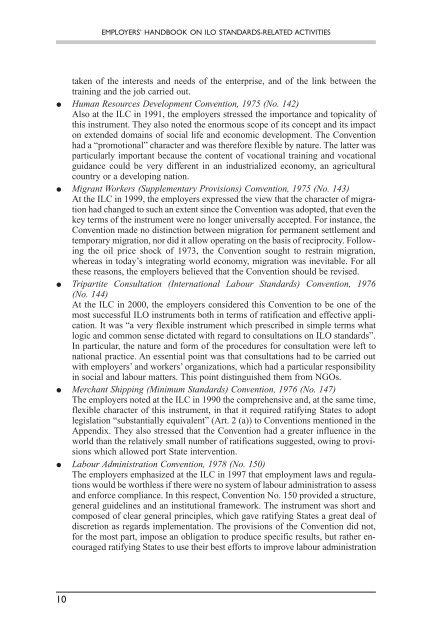Employers' Handbook on ILO Standards-related Activities
Employers' Handbook on ILO Standards-related Activities
Employers' Handbook on ILO Standards-related Activities
Create successful ePaper yourself
Turn your PDF publications into a flip-book with our unique Google optimized e-Paper software.
10<br />
EMPLOYERS’ HANDBOOK ON <strong>ILO</strong> STANDARDS-RELATED ACTIVITIES<br />
taken of the interests and needs of the enterprise, and of the link between the<br />
training and the job carried out.<br />
l Human Resources Development C<strong>on</strong>venti<strong>on</strong>, 1975 (No. 142)<br />
Also at the ILC in 1991, the employers stressed the importance and topicality of<br />
this instrument. They also noted the enormous scope of its c<strong>on</strong>cept and its impact<br />
<strong>on</strong> extended domains of social life and ec<strong>on</strong>omic development. The C<strong>on</strong>venti<strong>on</strong><br />
had a “promoti<strong>on</strong>al” character and was therefore flexible by nature. The latter was<br />
particularly important because the c<strong>on</strong>tent of vocati<strong>on</strong>al training and vocati<strong>on</strong>al<br />
guidance could be very different in an industrialized ec<strong>on</strong>omy, an agricultural<br />
country or a developing nati<strong>on</strong>.<br />
l Migrant Workers (Supplementary Provisi<strong>on</strong>s) C<strong>on</strong>venti<strong>on</strong>, 1975 (No. 143)<br />
At the ILC in 1999, the employers expressed the view that the character of migrati<strong>on</strong><br />
had changed to such an extent since the C<strong>on</strong>venti<strong>on</strong> was adopted, that even the<br />
key terms of the instrument were no l<strong>on</strong>ger universally accepted. For instance, the<br />
C<strong>on</strong>venti<strong>on</strong> made no distincti<strong>on</strong> between migrati<strong>on</strong> for permanent settlement and<br />
temporary migrati<strong>on</strong>, nor did it allow operating <strong>on</strong> the basis of reciprocity. Following<br />
the oil price shock of 1973, the C<strong>on</strong>venti<strong>on</strong> sought to restrain migrati<strong>on</strong>,<br />
whereas in today’s integrating world ec<strong>on</strong>omy, migrati<strong>on</strong> was inevitable. For all<br />
these reas<strong>on</strong>s, the employers believed that the C<strong>on</strong>venti<strong>on</strong> should be revised.<br />
l Tripartite C<strong>on</strong>sultati<strong>on</strong> (Internati<strong>on</strong>al Labour <strong>Standards</strong>) C<strong>on</strong>venti<strong>on</strong>, 1976<br />
(No. 144)<br />
At the ILC in 2000, the employers c<strong>on</strong>sidered this C<strong>on</strong>venti<strong>on</strong> to be <strong>on</strong>e of the<br />
most successful <strong>ILO</strong> instruments both in terms of ratificati<strong>on</strong> and effective applicati<strong>on</strong>.<br />
It was “a very flexible instrument which prescribed in simple terms what<br />
logic and comm<strong>on</strong> sense dictated with regard to c<strong>on</strong>sultati<strong>on</strong>s <strong>on</strong> <strong>ILO</strong> standards”.<br />
In particular, the nature and form of the procedures for c<strong>on</strong>sultati<strong>on</strong> were left to<br />
nati<strong>on</strong>al practice. An essential point was that c<strong>on</strong>sultati<strong>on</strong>s had to be carried out<br />
with employers’ and workers’ organizati<strong>on</strong>s, which had a particular resp<strong>on</strong>sibility<br />
in social and labour matters. This point distinguished them from NGOs.<br />
l Merchant Shipping (Minimum <strong>Standards</strong>) C<strong>on</strong>venti<strong>on</strong>, 1976 (No. 147)<br />
The employers noted at the ILC in 1990 the comprehensive and, at the same time,<br />
flexible character of this instrument, in that it required ratifying States to adopt<br />
legislati<strong>on</strong> “substantially equivalent” (Art. 2 (a)) to C<strong>on</strong>venti<strong>on</strong>s menti<strong>on</strong>ed in the<br />
Appendix. They also stressed that the C<strong>on</strong>venti<strong>on</strong> had a greater influence in the<br />
world than the relatively small number of ratificati<strong>on</strong>s suggested, owing to provisi<strong>on</strong>s<br />
which allowed port State interventi<strong>on</strong>.<br />
l Labour Administrati<strong>on</strong> C<strong>on</strong>venti<strong>on</strong>, 1978 (No. 150)<br />
The employers emphasized at the ILC in 1997 that employment laws and regulati<strong>on</strong>s<br />
would be worthless if there were no system of labour administrati<strong>on</strong> to assess<br />
and enforce compliance. In this respect, C<strong>on</strong>venti<strong>on</strong> No. 150 provided a structure,<br />
general guidelines and an instituti<strong>on</strong>al framework. The instrument was short and<br />
composed of clear general principles, which gave ratifying States a great deal of<br />
discreti<strong>on</strong> as regards implementati<strong>on</strong>. The provisi<strong>on</strong>s of the C<strong>on</strong>venti<strong>on</strong> did not,<br />
for the most part, impose an obligati<strong>on</strong> to produce specific results, but rather encouraged<br />
ratifying States to use their best efforts to improve labour administrati<strong>on</strong>

















